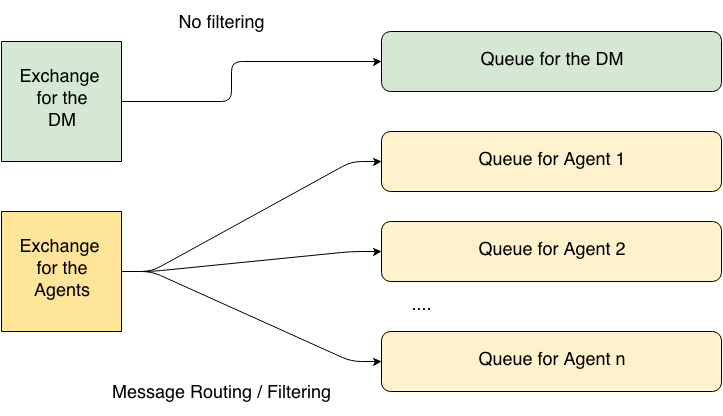Understanding the Messaging with Rabbit MQ
This page explains Rabbit MQ’s support in Roboconf for versions from 0.1 to 0.5 (included).
For more recent versions, please refer to this page.
First, it is highly recommended to read Rabbit MQ’s tutorial.
It explains the basics and the concepts of this messaging server.
Now, let’s talk about the way Roboconf uses RabbitMQ.
Global Schema
This schema illustrates what is discussed below.

Clients and Queues
The DM and all the agents have their own client for RabbitMQ.
Each of them has also its own queue. And all of this is contextual within an application.
The DM’s queue is called…
<application-name>.dm
The queue for an agent is named according to the root/scoped instance it is associated with.
Within a Roboconf application, instance paths are unique. When an agent starts, it is associated
with a root/scoped instance. The name of an agent’s queue is thus…
<application-name>.<root-instance-name>
Exchanges
There are 2 exchanges.
Exchanges are important because no client sends directly a message to a queue.
Queues are hidden behind exchanges.
The first exchange is for the Deployment Manager. All the messages sent to this exchange will be forwarded to the DM’s queue (broadcast). This exchange name is called…
<application-name>.admin
The second exchange is used for all the agents.
When the DM or an agent wants to send something to agent, it will use this exchange.
<application-name>.agents
Routing Keys
The DM’s exchange forwards all the messages it receives to the DM queue.
However, the agents’ exchange forwards a message to this agent’s queue or that agent’s queue
through a routing key. To simplify the agent’s code, the routing key is not determined in the agent module
but in the messaging module.
Routing keys are deduced from variables names.
The variables are what component instances export or import (the famous runtime dependencies).
Example
Let’s consider the following instances.
We assume they are already associated with an agent.
-
MyWebApplication is an instance of WebApplication.
It exports WebApplication.ip and WebApplication.port.
It imports MySql.ip and MySql.port. -
MyDatabase is an instance of MySql.
It exports MySql.ip and MySql.port. And it imports nothing.
-
We deploy MyWebApplication.
The agent starts listening messages sent to those.that.exports.MySql. -
We start MyWebApplication.
It publishes the variables it exports to those.exports.WebApplication. Those that listen it will receive them. -
We deploy MyDatabase.
There is no import, so the agent has nothing to listen to. -
We now start MyDatabase.
It publishes the variables it exports to those.exports.MySql. Those that listen it, including the MyWebApplication instance, will receive them.
When we say an agent publishes, it sends a message to the agent exchange, with the right routing key those.exports.(…).
When we say an agent listens, it actually binds its queue with the agent exchange AND the right routing key those.exports.(…).
By creating bindings between queues and the agents’ exchange, we determine routes for messages.
And we are sure the messages only reach the clients that actually need this information.